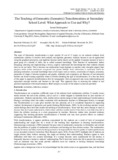Please use this identifier to cite or link to this item:
https://cris.library.msu.ac.zw//handle/11408/1605Full metadata record
| DC Field | Value | Language |
|---|---|---|
| dc.contributor.author | Mashingaidze, Samuel | - |
| dc.date.accessioned | 2016-06-20T14:38:35Z | - |
| dc.date.available | 2016-06-20T14:38:35Z | - |
| dc.date.issued | 2012 | - |
| dc.identifier.issn | 1911-2017 | - |
| dc.identifier.uri | http://www.ccsenet.org/journal/index.php/ass/article/view/22662 | - |
| dc.identifier.uri | http://hdl.handle.net/11408/1605 | - |
| dc.description.abstract | The topic of Geometric transformation is topic number 10 out of 11 topics on the national ordinary level mathematics syllabus. It involves both analytic and algebraic geometry. Analytic because it can be approached using the graphical perceptive, and algebraic because matrix theory can be applied. It requires learners to have a good grasp of a number of skills, the so called assumed knowledge. Thus Teachers of mathematics before designing, selecting and implementing a lesson, ought to understand the knowledge that their students already have (or do not have). This is because one mathematical topic depends on another, early strengths support later progress while earlier weaknesses compound into greater debility. Such information is extremely useful for planning instruction. Assumed knowledge base covers topics such as vectors, construction of shapes, symmetry, properties of shapes, Cartesian equations and graphs, similarity and congruency, etc. Because of such demands learners are found wanting especially where it involves deciding the type of transformation. It is thus the thrust of this paper to approach transformations first by using graphs. Such an approach may cause understanding and enjoyment amongst teachers and learners in the topic. This approach aims at exposing the student to real practical experiences with transformations. Brief synopses on issues of the subject content are provided. | en_US |
| dc.language.iso | en | en_US |
| dc.publisher | Canadian Center of Science and Education | en_US |
| dc.relation.ispartofseries | Asian Social Science;Vol. 8, No. 15; p. 197-210 | - |
| dc.subject | Translation, reflection, rotation | en_US |
| dc.title | The teaching of geometric (Isometric) transformations at secondary school level: what approach to use and why? | en_US |
| dc.type | Article | en_US |
| item.openairetype | Article | - |
| item.languageiso639-1 | en | - |
| item.fulltext | With Fulltext | - |
| item.openairecristype | http://purl.org/coar/resource_type/c_18cf | - |
| item.cerifentitytype | Publications | - |
| item.grantfulltext | open | - |
| Appears in Collections: | Research Papers | |
Files in This Item:
| File | Description | Size | Format | |
|---|---|---|---|---|
| the teaching.pdf | Full Text | 707.58 kB | Adobe PDF |  View/Open |
Items in MSUIR are protected by copyright, with all rights reserved, unless otherwise indicated.



